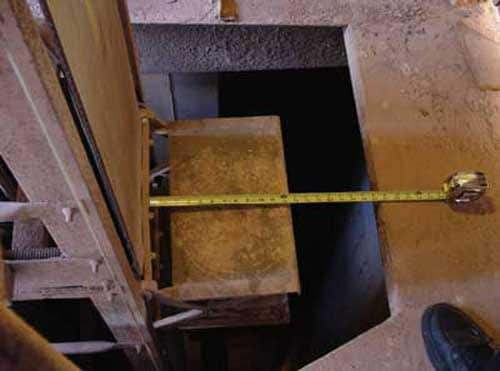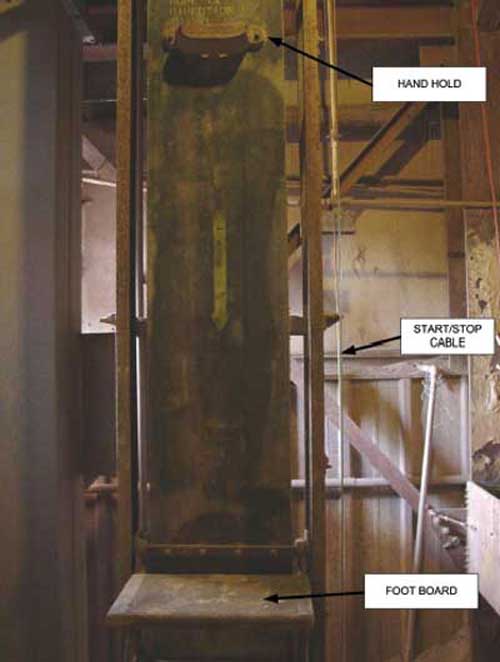[Udated below (Sept 5, 2013)]
Jay Van Buskirk, 47, was employed less than a year at the ConAgra Foods flour mill in Alton, Illinois, before falling to his death on August 4, 2012. The St. Louis Post-Dispatch reports:
"Van Buskirk was standing on a man lift platform and moving between the fourth and fifth floors of the nine-story flour mill when he fell. The Madison County Coroner's Office reported that the death was due to head trauma and that the fall was as much as 74 feet. According to the coroner's office, the man had complained of feeling dizzy prior to the fall."
A week earlier it was Brett Alan Hauk, 51, who fell to his death from a manlift at the Pepisco Quaker plant in Danville, Illinois. The coverage in the local newspaper indicates Mr. Hauk fell about five stories.
When I read these stories I also thought of Robert Fitch, 51, of Lincoln, Nebraska who also fell to his death in January 2009 from a manlift. In Mr. Fitch's case it was an Archer Daniels Midland plant.
Three multi-national corporations. Three manlift fatalities.
Belt-operated manlifts date back to the late 1800's. They are installed in multi-story plants to transport personnel up and down floors more quickly than using stairs, and without the expense or space required by an elevator. The photos below are from the scene of a worker fatality in 2005 at a livestock feed plant. The belt-operated manlift dated back to the 1930's.

(Photo credit: NIOSH, Firefighter fatality investigation report, August 2006)
One worker described to me these manlifts as vertical conveyor belts. They run on a continuous loop from the ground to the top floor of a plant. They travels at about 75 feet per minute. Affixed to the belt are small platforms for your feet, "the size of that placemat," he said, every 8 feet or so, along with small handholds. Riding the manlift requires reaching with both hands for the small handle in the center of the belt and stepping onto the platform over an opening in the floor. You'll ride it up (or down) to the floor that beckons you and then you "step off"---all while the belt if moving.

(Photo credit: NIOSH, Firefighter fatality investigation report, August 2006)
The OSHA regulations that govern manlifts date back to 1974 and are based on a 1969 industry-consensus standard. They are not only seriously out-of-date, but manlifts installed prior to 1971 do not have to conform to even these out-dated OSHA rules.
Although OSHA regulations are stuck in a time warp, professional organizations such as the American Society of Mechanical Engineers (ASME) research and develop safety standards and encourage employers to follow them. ASME has its own safety standard and recommendations for manlifts, the most recent version issued in 2009.
Federal OSHA inspectors have been on the scene at both the ConAgra plant in Alton, IL and the Pepsico plant in Danville, IL. They are conducting a post-fatality inspection and will determine whether the workplace (or at least the area where the fatality occurred) is in compliance with OSHA safety and health regulations. But with outdated rules on the books, and contributing factors that are not addressed at all by specific OSHA standards, we're missing a real opportunity to learn how to prevent fatal falls from manlifts.
Because people aren't robots, the wisest and most effective safety interventions will focus on eliminating or controlling the hazard at its source. People get rushed. People feel pressure. People get dizzy. People want to work fast and please their boss. People feel distracted. For those reasons, employers should not rely heavily on interventions like safety stickers or simple reminders to "be careful as you step over that hole in the floor and the five stories below it." I wonder whether the safety programs of these very large firms rely heavily on "worker behavior" techniques----"be safe," "be careful," --- or have they instituted higher-order protections that recognize that people are not robots. Do these firms follow the ASME 90.1 (2009) standards for manlifts? Besides telling workers to "hold on with both hands" and "step on and off carefully," what structures are in place to prevent falls from the manlifts? Comprehensive fatality investigations would examine these and a full-range of other factors that may have contributed to these incidents. Such investigations could certainly offer answers to "what went wrong" and provide worthwhile ideas for preventing them in the future.
ConAgra, Pepisco and ADM all boast of their stellar workplace safety programs. Given that all three have had employees die on the job while using belt-operated manlifts, I wonder if they'd consider letting a group of independent investigators examine how their safety program and manlift operations failed Robert Fitch, 51, Brett Alan Hauk, 51, and Jay Van Buskirk, 47, and their families. If they'll open their records, I'll convene the team.
[Udated below (Sept 5, 2013)]: OSHA conducted post-fatality inspections at all three of these locations. For the two fatalities in Illinois in July and August 2012, neither ConAgra or Quaker/Pepsico Manufacturing received citations or penalties (see here, here).

I am the proud niece of Uncle Bobby (Robert Fitch) who was taken so drastically from us because of this hazardous device. Thank you for this great post...brings back a lot of unwanted memories and memories that I never want to forget. My thoughts go out to the families and friends of Mr. Van Buskirk and Mr. Hauk. It is time to make a change and make sure that our families come home after their shift.
Regardless of the risks associated with these types of devices, OSHA's Fall Protection Standard applies whenever a worker goes 4 feet above grade (6 feet in Construction). Where was the Fall Protection Equipment, Training and Inspections that were required in all of these applications?
KJP.
Ken,
Good question. I'll have to do a little digging, but I don't think the general industry fall protection requirements apply to these manlifts.
Just as with ladders of various sorts, the 4 foot/6 foot requirement does not apply when the worker is using a manlift (the ladder, or in this case the manlift, has its own set of requirements and if those are met the employer is in compliance without regard to the general fall protection requirements). The fall protection requirements might apply to the area around the lift, depending upon the circumstances.
I do know that when we were trained they told anyone that was uncomfotable riding the manlift shouldnt.
Michael Wood, your point is well-taken; however, there is a catch-all in the regs that puts responsibility on the employer to take all necessary and practicable means to protect employees and ensure a safe and healthful work environment. We're not back in the 40s here, and I'm sure ConAgra wouldn't hide behind the ladder regs or tout their 'compliant' manlifts as a shining examples of safety (Hauk, VanBuskirk and Fitch's families would be irate). In the realm of what's reasonable and possible, what's wrong with snap-on restraints, side panels and minimizing the shaft gap at the end of the footboard? or even a good old-fashioned seatbelt, but with quick-release? But then, if the US Govt won't require seatbelt restraints on our school buses, why bother with manlifts?
And Steve Zasko, as a Manager, I would never ask an employee to do something that I wouldn't do myself. I would be more than uncomfortable riding these lifts as designed, and would not expect any of my team members to ride them. Glad your employer gave you the option, but that still does not adequately protect the riders who have a stronger comfort level.
I'll get off the soapbox now. We all want the safest environment for our workforce, and I think we have so much opportunity to do a better job of this. Any of you readers who have ever had to call a worker's family at 2am and tell them that their loved one is never coming home again, I'm sure you can understand my feelings.
Best Regards,
Kenneth J. Pretell, REA
I am an officer in the labor union, and work at a ConAgra Mill. I ride their manlifts daily. While It would be a stretch to say Conagra's safety program is stellar, they do a very good of training people on manlift use. These devices, when used properly are no more dangerous than walking the stairs. Given the details of VanBuskirk's situation, stairs would more then likely also have been fatal.
Jake, what do you mean the details of VanBuskirk's situation?
If the manlift is properly maintained and the riders are properly trained the manlift is no more dangerous than any other conveyance system. You can not wear fall protection on a manlift. The manlift is in continuous motion. you would not be able to disconnect your lanyard while in motion. People with health issues should not ride the manlift. Vehicles travel at high rates of speed in opposite directions separated by a 6" paint stripe on many of our highways is this not equally as dangerous? should we ban cars or shut down our highways? anyone uncomfortable should not ride a manlift. Nor should they carry anything on the manlift. There are a large number of accidents on escalators each year. I have heard no mention of taking them out of service.
Courtney, I think what Jake is referring to is that the article stated that Mr. VanBuskirk was feeling dizzy prior to the fall. Had he been dizzy and fallen down a long flight of metal stairs he would have been seriously injured or dead. I personally have ridden these very same type of manlifts. It is just like anything else in an industrial setting, you must put safety first and use equipment correctly. I will admit that these manlifts are a bit archaic but they can be used safely. Workers here in Wyoming use these man lifts regularly everyday, and falls are not typical. Workers in the plants I visited are held to strict guidelines while using the manlifts. They are not allowed to carry tools or take their hands or feet off of the platform/handhold. Also, one should never use powered equipment if they are feeling dizzy or sick in any way and should try to stay away from stairs as well if at all possible. As to being strapped on to one of these devices, even with quick release straps, I cannot agree. Becoming accidently stuck on one of these devices would be just as catastrophic as falling off of one. I believe Mr. VanBuskirk's circumstances are extenuating. What a tragic accident. My sympathies go out to his family.
I agree with Tracy, Although tragic what happened, they can be used safely and the power plants I've used them at have specific training for them also stairs and elevators are available for use.
Just because someone can be trained to manipulate their body position and take physical action to avoid a crush or fall does not mean it has met a reasonable standard for safety.
It is against the law and every safety standard there is to ride an industrial conveyor, with the one exception being a manlift. Every year people are killed on these machines while safer methods are available. It is time for them to be prohibited.